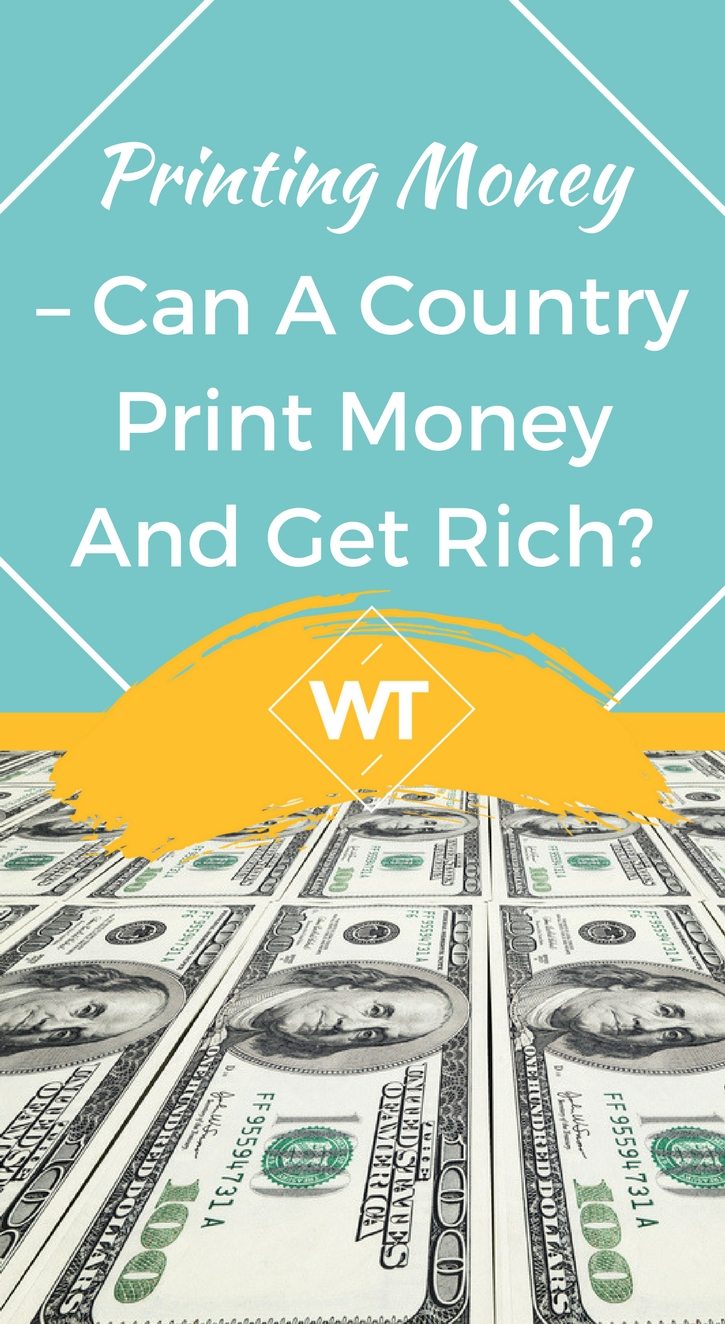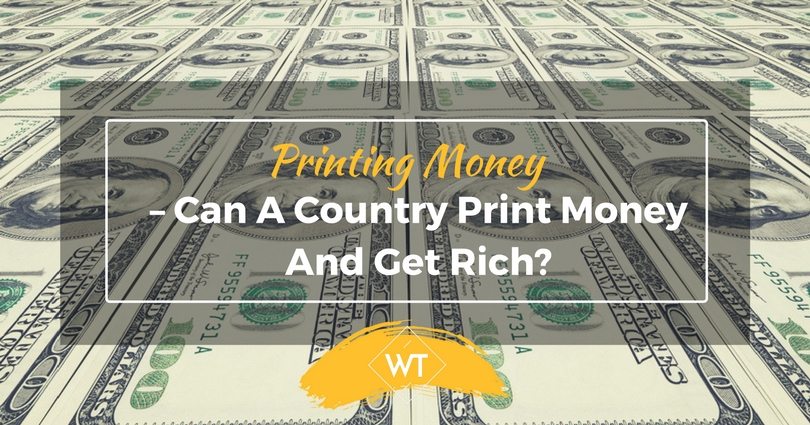Printing Money – Can a Country print Money and get Rich?

When I was kid I used to wonder what stops government from printing money? Can’t a country just print money and distribute that money to its citizens?
We used to hear that Mr X is earning more than Mr Y. So Mr. X is richer than Mr.Y. Rich and poor is decided on the basis of money one possesses. So it would be wonderful if government decides to distribute money to everyone so that everyone lives a comfortable life!!
In fact, in recessionary times – countries do resort to printing money, or what is known as Quantitative Easing (QE), – a term that became popular just after the recession in 2008. But, that measure is only for extreme situations, and is also considered dangerous because printing money causes inflation in an economy, and if you print too much money you can get hyper – inflation also.
Example : Almost 2-3 years back 3 eggs could have cost you 100 billion dollar “Zimbabwe” bank note. So basically we are talking about total devaluation of currency. Off course this is extreme but it shows the capability of inflation beast.
What determines the amount of money a country can print?
There is no fixed yard stick which determines the amount of printed money by central bank. It should be sufficient to make transfer of goods and services smooth and at the same time restore the value of currency.
Value of currency depends on many factors e.g. net exports, Current and fiscal deficit, Interest rate in the economy among many moving parameters.
Generally speaking central bank prints almost 2-3% money of total GDP. But this amount of money varies a lot from economy to economy. Mature or developed market prints 2-3% of their GDP. Emerging economy like India has much more than 2-3% money in circulation.
Black money plays a big role in in currency circulation and hence amount of money available in the legal channel.
How much money is enough?
Now the question is how much currency should government print in order to circulate so that they can transact things? So we have on one hand goods and services produced in the economy and on the other hand currency to make movement or transact these produced things better and swifter. So now imagine, India as a country produce only 1 kg of rice in a year.
Govt has the option of printing as much money as they want. They can print 100 Rs in form of 100 notes of 1 Rs or 200 Rs in form of 200 notes of 1 Rs this way. The difference between these two situations is nothing but we have either 100 Rs or 200 Rs to buy this same quantity i.e. 1 kg of rice.
This is very simplistic scenario but it is very relevant to lay the foundation for understanding the role of currency.
Printing money – Why does the government print money?
Then the natural question now is why government prints more money when it is not creating any value for the economy. They have the entire literate and qualified person advising them to keep printing money i.e. after US recession of 2008
Incremental Money Supply
Now we will take different scenario i.e. we have only 100 notes of 1 Rs and we have 200 people in our country. So in order to enable everybody to transact we need at least 200 notes. So this is one of many reasons why country needs to print incremental money.
In developing economies like India, Indonesia or china every year millions of their citizens are coming out of poverty. Government has to provide currency to these residents so that their demands (currency) can be met. Incremental money supply should be proportional to real output in the economy otherwise it will create excess supply of currency.
Excess supply of money feeds into inflation and hence reduces buying power. So printing money helps if it is done proportionately with real output.
Now imagine a relatively sophisticated economy, where demand of currency and supply of the same is proportional to the goods and services produced by the economy. In these circumstances prices of goods and services would be in equilibrium at any point of time.
Illustration
Now imagine our government becomes generous and transfers 1 crore to every citizen’s bank account. In order to meet this they start printing money and distribute it to everyone.
Now everyone becomes richer by 1 crore. In this situation people will start buying cars, air conditioners, fridge and all the things which they were not able to afford earlier. Now the demand is increased for almost all the goods and services because purchasing power has been increased.
On the other hand since no technological development has happened or real output has not been increased, aggregate supply of goods and services will remain the same. This new changed environment has destructed the equilibrium of demand supply dynamic equilibrium.
So the prices of goods and services in economy would adjust to the level where growth in the money supplied or demand will completely reflect in the price increase. So the situation comes to the back to square one i.e. no one becomes richer since they did not have any incremental buying power.
Printing Money – Conclusion
In the process of becoming rich, a country needs to be technologically advanced and more competitive. The increase in national income will be purely monetary (nominal). The reason is that printing money or more money doesn’t improve economic output in any way. It merely causes inflation.
In the process of becoming rich, a country needs to be technologically advanced and more competitive. A country proceeds on the path of economic growth by fetching money through higher demand of locally produced goods and services.








Leave a Reply